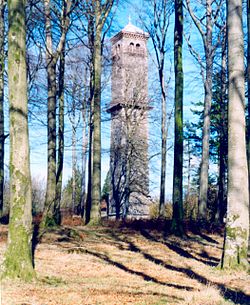Cranmore Tower
| Cranmore Tower | |
|
Somerset | |
|---|---|

| |
| Type: | Folly |
| Location | |
| Grid reference: | ST67674502 |
| Location: | 51°12’13"N, 2°27’51"W |
| Village: | Cranmore |
| History | |
| Built 1862-1864 | |
| For: | John Moore Paget by Henry Goodridge |
| Folly | |
| Information | |
| Website: | www.cranmoretower.co.uk |
The Cranmore Tower is a 19th century folly tower 148 feet tall in the parish of Cranmore in Somerset.[1] The site is 920 feet above sea level, and is the highest point on the Mendip Way.
The tower was built in 1862-1864, by Thomas Henry Wyatt for John Moore Paget of Cranmore Hall (now part of All Hallows Preparatory School). There is a viewing area at the top with pair of semi-circular headed openings to each face with a restored iron-railed balcony beneath each pair. A similar balcony just over halfway up is continued right round the tower. It has been designated as a Grade II listed building.[2]
In the Second World War the tower was used as a lookout tower by the Home Guard and the Royal Corps of Signals.[3]
By 1984 the tower had fallen into disrepair and was sold to Donald Beaton who undertook repairs. During the course of the repairs the remains of a Roman fort with a hoard of coins was discovered adjacent to the tower. In 1988 it was sold again, this time to Nick Ridge who opened it to the public.[3] The tower was then acquired by followers of the Baha'i religion. Further restorations were carried out, including the installation of a new timber staircase to allow access to the balconies at the top of the tower at a height of 1,050 feet above sea level.
From early 2008 the tower has been again open to the public, in particular being marketed as a romantic setting for proposals of marriage. A small fee is usually charged to ascend the tower which is open on weekends, bank and school holidays and by arrangement.
References
- ↑ Cranmore Tower
- ↑ National Heritage List 1216763: Cranmore Tower
- ↑ 3.0 3.1 Holt, Jonathan (2007). Somerset Follies. Bath: Akeman Press. pp. 72. ISBN 978-0-9546138-7-7.